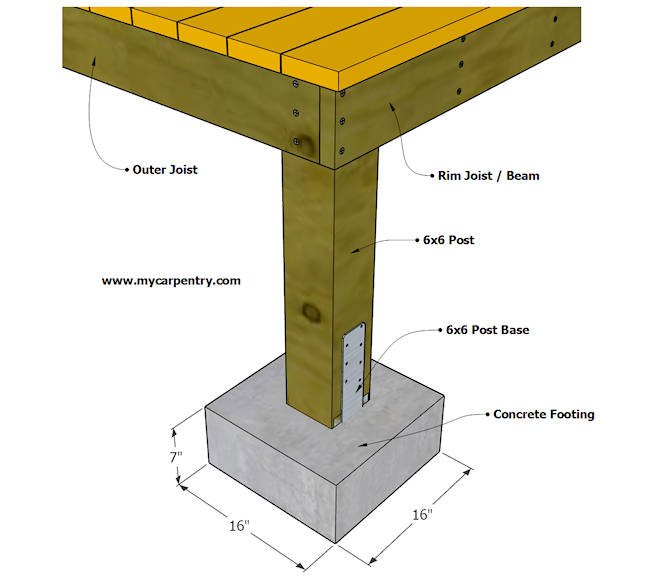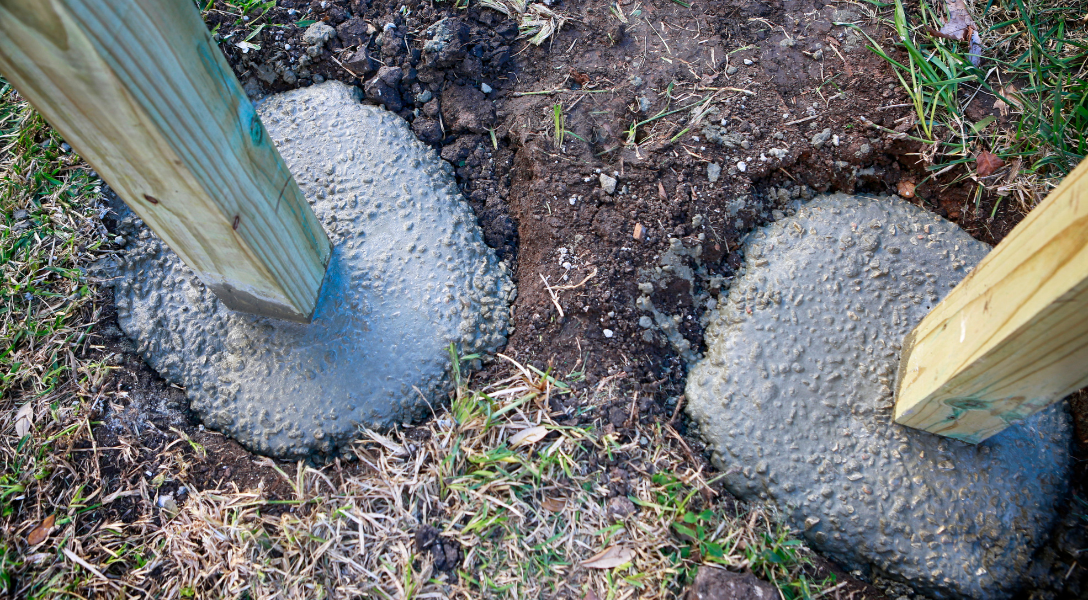Achieving Excellence: The Duty of Correct Deck Footings in Your Task's Success
Wiki Article
Vital Tips for Solid Deck Ground: A Comprehensive Guide
Building a deck is a financial investment that calls for careful planning and focus to detail, particularly when it comes to the footing. This guide will cover essential elements such as selecting the best materials, evaluating soil conditions, determining lots capacity, establishing correct ground depth, and attaining accurate installment. Let's dive into the globe of strong deck ground and establish a foundation you can rely on.Picking the Right Deck Ground Products
When selecting the ideal deck ground materials, it is crucial to consider the particular demands and needs of your task. The quality and toughness of the grounds directly affect the stability and durability of the deck framework. There are numerous variables to consider when selecting deck footing products.One essential consideration is the sort of soil in your area. Different dirt types have varying load-bearing capacities and drainage buildings. Clay dirts have a tendency to maintain water, while sandy soils drain quickly. Understanding your dirt conditions will help you choose grounds that can properly sustain the weight of the deck and stop problems such as sinking or heaving.
One more factor to consider is the environment in your area. Extreme temperature levels, wetness levels, and freeze-thaw cycles can influence the performance of deck grounds. In cool climates, as an example, frost heave can trigger footings to crack or change. In such cases, making use of frost-resistant materials or installing grounds listed below the frost line can help alleviate these risks.
Additionally, the dimension and design of your deck must also influence your selection of footing materials. Larger or more intricate decks may require deeper or enhanced footings to make sure sufficient assistance. Understanding the certain lots requirements of your deck will certainly aid you identify the ideal products to use.
Eventually, picking the best deck ground materials entails careful consideration of aspects such as soil problems, environment, and deck layout. By taking these elements into account, you can select grounds that provide the required support, improve the security of your deck, and guarantee its longevity.
Correctly Examining Dirt Problems
To properly evaluate soil conditions for your deck footing, it is important to thoroughly examine the load-bearing capabilities and water drainage residential properties of the dirt in your location. Recognizing the dirt's capability to birth weight and its capacity to drain pipes excess water will certainly assist make sure the security and durability of your deck.When examining the load-bearing ability of the soil, it is essential to think about elements such as soil compaction, density, and kind. Various dirt types have differing load-bearing abilities, with compressed soils generally using better assistance than sandy or loose soils. Performing a dirt test can give beneficial details regarding the soil's ability to sustain the weight of your deck.
Furthermore, assessing the drainage residential or commercial properties of the dirt is important to stop water build-up and potential damages to your deck - Deck Footings. Poor drain can lead to moisture build-up, which can deteriorate the foundation and create architectural concerns. It is very important to assess the dirt's capability to drain pipes water successfully to prevent these troubles
Consulting with an expert engineer or dirt professional can considerably assist in effectively evaluating dirt conditions for your deck ground. They can offer experienced guidance and guidance, making sure that you choose the appropriate footing layout and materials based upon the specific qualities of the soil in your area. Putting in the time to thoroughly evaluate soil problems will help you develop a strong and resilient deck.
Determining Tons Ability for Footings
One crucial step in making certain the stability of your deck is to properly compute the tons ability for your grounds. Deck Footings. The load capability describes the optimum amount of weight or load that the grounds can securely support without causing any type of architectural damages or failure. Determining the tons ability for grounds involves thinking about numerous variables such as the dimension and sort of grounds, the kind of dirt, the dimensions and weight of the deck, and the online look at this web-site lots and dead lots that the deck will certainly undergoTo determine the lots capacity, it is essential to consult local structure codes and regulations as they give certain standards and requirements for deck building and construction. These codes think about aspects such as dirt bearing capacity, frost depth, and minimal ground measurements. Furthermore, it is crucial to engage the services of an expert contractor or a structural engineer who can execute the necessary calculations and evaluations to make sure the safety and security and security of the deck.
When computing the tons capability, it is necessary to precisely identify the live load and dead lots that the deck will certainly experience. The online tons refers to the weight of individuals, furnishings, and any kind of various other items that will certainly be positioned on the deck, while the dead tons refers to the weight of the deck itself. By properly figuring out these tons and considering all relevant elements, you can ensure that your grounds are adequately developed to sustain the weight and preserve the security of your deck.
Making Sure Correct Footing Deepness
Appropriate ground depth is important for ensuring the security and longevity of your deck. The deepness at which the footings are mounted directly influences the structural honesty of the deck, as it determines exactly how well the footings can withstand the pressures put in by the deck and the dirt underneath it.When determining the appropriate footing deepness, a number of variables need to be go to my blog considered. These include the kind of soil, the neighborhood environment, and the load capability needed for the deck. Typically, grounds should be put listed below the frost line to stop any kind of heaving or shifting because of cold and thawing cycles. In areas with extensive clay dirt, deeper footings might be necessary to offer appropriate support.
To determine the proper footing depth, it is suggested to speak with an architectural designer or building inspector who can evaluate the certain problems of your website and give guidance based on local building ordinance and guidelines. They will certainly take into consideration factors such as soil composition, water table level, and expected loads to identify the minimum required ground deepness.
Installing Footings With Accuracy
Mounting grounds with precision is important for guaranteeing the security and structural integrity of your deck. Properly mounted grounds supply a solid structure, making certain that your deck can stand up to the weight of furniture, individuals, and various other tons. To install grounds with precision, there are several vital actions to follow.To start with, it is essential to precisely mark the area of each footing. This can be done by utilizing a string or chalk line to develop read this post here a clear rundown. By measuring and noting the precise positions, you can make sure that the footings are equally spaced and lined up.
Following, you need to dig the openings for the footings. It is essential to dig them to the proper depth and size, as specified by neighborhood building codes and laws. This will provide ample support and prevent the deck from moving or sinking with time.
When the openings are dug, it is necessary to degree and small the soil at the bottom of each opening. This will develop a stable base for the footing to rest on and prevent any type of settling or movement.
After preparing the openings, you can wage putting the concrete. Use a concrete mix that is appropriate for grounds and follow the maker's instructions for mixing and pouring. Make certain that the concrete fills the openings entirely and is level with the ground surface.
Last but not least, allow the concrete to cure appropriately before waging the building and construction of your deck. This will guarantee that the grounds are stable and strong, supplying a safe and secure foundation for your deck.

Verdict
In verdict, making certain strong deck ground is important for the stability and longevity of a deck framework. By picking the proper footing materials, assessing dirt conditions, calculating load ability, and setting up footings with accuracy, the threat of structural failing can be lessened. Complying with these vital tips will certainly assist create a solid structure for any deck task.Comprehending your soil problems will help you pick footings that can effectively sustain the weight of the deck and avoid concerns such as heaving or sinking.
Consulting with a professional designer or soil specialist can considerably aid in appropriately assessing dirt conditions for your deck ground. Determining the load ability for footings entails thinking about various factors such as the dimension and type of footings, the type of dirt, the dimensions and weight of the deck, and the real-time lots and dead load that the deck will certainly be subjected to.

Report this wiki page